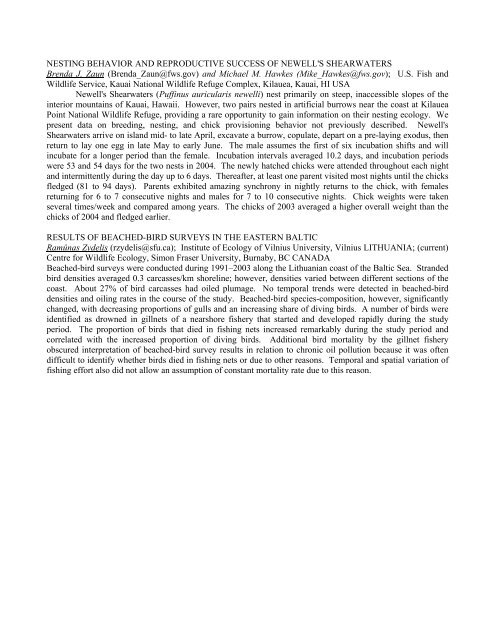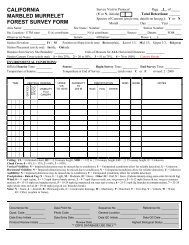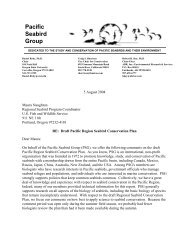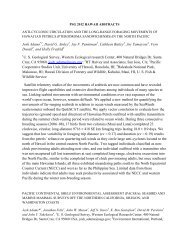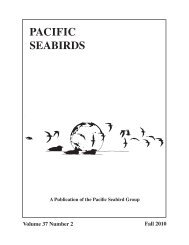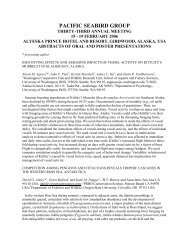abstracts of oral and poster presentations - Pacific Seabird Group
abstracts of oral and poster presentations - Pacific Seabird Group
abstracts of oral and poster presentations - Pacific Seabird Group
You also want an ePaper? Increase the reach of your titles
YUMPU automatically turns print PDFs into web optimized ePapers that Google loves.
NESTING BEHAVIOR AND REPRODUCTIVE SUCCESS OF NEWELL'S SHEARWATERS<br />
Brenda J. Zaun (Brenda_Zaun@fws.gov) <strong>and</strong> Michael M. Hawkes (Mike_Hawkes@fws.gov); U.S. Fish <strong>and</strong><br />
Wildlife Service, Kauai National Wildlife Refuge Complex, Kilauea, Kauai, HI USA<br />
Newell's Shearwaters (Puffinus auricularis newelli) nest primarily on steep, inaccessible slopes <strong>of</strong> the<br />
interior mountains <strong>of</strong> Kauai, Hawaii. However, two pairs nested in artificial burrows near the coast at Kilauea<br />
Point National Wildlife Refuge, providing a rare opportunity to gain information on their nesting ecology. We<br />
present data on breeding, nesting, <strong>and</strong> chick provisioning behavior not previously described. Newell's<br />
Shearwaters arrive on isl<strong>and</strong> mid- to late April, excavate a burrow, copulate, depart on a pre-laying exodus, then<br />
return to lay one egg in late May to early June. The male assumes the first <strong>of</strong> six incubation shifts <strong>and</strong> will<br />
incubate for a longer period than the female. Incubation intervals averaged 10.2 days, <strong>and</strong> incubation periods<br />
were 53 <strong>and</strong> 54 days for the two nests in 2004. The newly hatched chicks were attended throughout each night<br />
<strong>and</strong> intermittently during the day up to 6 days. Thereafter, at least one parent visited most nights until the chicks<br />
fledged (81 to 94 days). Parents exhibited amazing synchrony in nightly returns to the chick, with females<br />
returning for 6 to 7 consecutive nights <strong>and</strong> males for 7 to 10 consecutive nights. Chick weights were taken<br />
several times/week <strong>and</strong> compared among years. The chicks <strong>of</strong> 2003 averaged a higher overall weight than the<br />
chicks <strong>of</strong> 2004 <strong>and</strong> fledged earlier.<br />
RESULTS OF BEACHED-BIRD SURVEYS IN THE EASTERN BALTIC<br />
Ramûnas Zydelis (rzydelis@sfu.ca); Institute <strong>of</strong> Ecology <strong>of</strong> Vilnius University, Vilnius LITHUANIA; (current)<br />
Centre for Wildlife Ecology, Simon Fraser University, Burnaby, BC CANADA<br />
Beached-bird surveys were conducted during 1991–2003 along the Lithuanian coast <strong>of</strong> the Baltic Sea. Str<strong>and</strong>ed<br />
bird densities averaged 0.3 carcasses/km shoreline; however, densities varied between different sections <strong>of</strong> the<br />
coast. About 27% <strong>of</strong> bird carcasses had oiled plumage. No temp<strong>oral</strong> trends were detected in beached-bird<br />
densities <strong>and</strong> oiling rates in the course <strong>of</strong> the study. Beached-bird species-composition, however, significantly<br />
changed, with decreasing proportions <strong>of</strong> gulls <strong>and</strong> an increasing share <strong>of</strong> diving birds. A number <strong>of</strong> birds were<br />
identified as drowned in gillnets <strong>of</strong> a nearshore fishery that started <strong>and</strong> developed rapidly during the study<br />
period. The proportion <strong>of</strong> birds that died in fishing nets increased remarkably during the study period <strong>and</strong><br />
correlated with the increased proportion <strong>of</strong> diving birds. Additional bird mortality by the gillnet fishery<br />
obscured interpretation <strong>of</strong> beached-bird survey results in relation to chronic oil pollution because it was <strong>of</strong>ten<br />
difficult to identify whether birds died in fishing nets or due to other reasons. Temp<strong>oral</strong> <strong>and</strong> spatial variation <strong>of</strong><br />
fishing effort also did not allow an assumption <strong>of</strong> constant mortality rate due to this reason.


